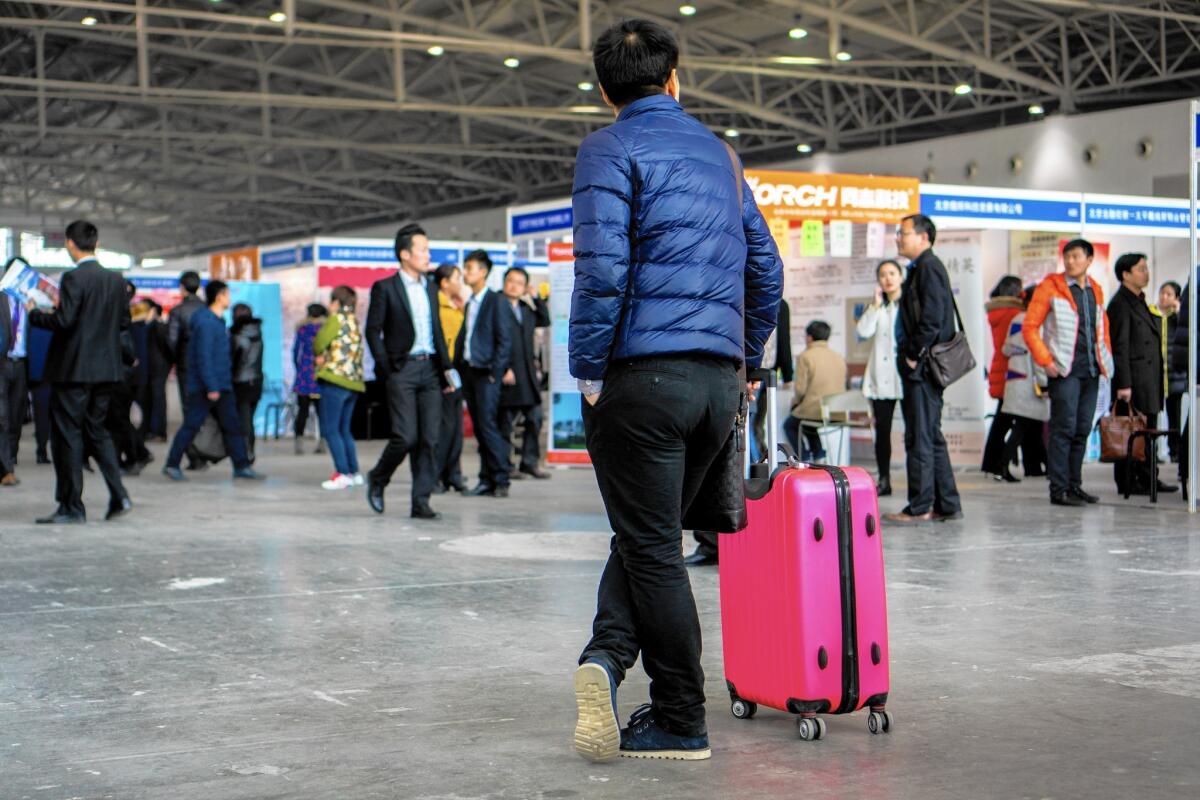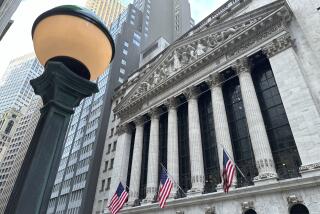Distrust of Chinese economic data stokes fear on Wall Street

Reporting from new york — In China, the official unemployment rate for years has invariably stayed below 5%, or around 10 million people, no matter what — even after the catastrophic 2008 financial crisis that sent jobless rates soaring elsewhere.
Except that a 2010 government white paper listed the country’s total labor force at 1.07 billion and the number of employed at 780 million — leaving a gap of about 290 million people without a job or underemployed.
“Because the Ministry of Human Resources counts as it likes, the unemployment rate never exceeds 5%,” wrote Derek Scissors, a resident scholar at the American Enterprise Institute in Washington who cited the gap in a 2013 paper. “It thus gives a wildly optimistic picture of overall unemployment.”
Welcome to the world of Chinese economic reporting.
Since mid-August, global stock markets have plummeted on news that China’s economy might be weakening faster than economists and analysts had expected. Nearly three weeks ago, the Dow Jones industrial average suffered its biggest one-day drop since 2008 and, as of Friday, was down 9.7% for the year.
But some analysts said the global market turmoil had less to do with the fundamentals of the Chinese economy than a fear of the unknown.
See the most-read stories this hour >>
China experts, and many investors, accept as a matter of course that the country’s official economic and financial data, including basic figures such as unemployment and its economic growth rate, are unreliable and invariably colored by political considerations.
“These numbers are wrong,” Scissors said. “They just are.”
And data about the state-owned financial system is even murkier. Scissors noted, for instance, that the figures for non-performing consumer and corporate loans — a critical measure of economic health — never goes up, even during massive credit expansions that followed the financial crisis.
Critics noted that China’s main data provider, the National Bureau of Statistics, is under control of the Communist Party and ruling State Council, which prize stability above all and are on guard against signs of unemployment and inflation that have sparked protests in the past.
The bureau’s report for the most recent quarter includes language strikingly different from that coming from its U.S. counterparts.
“The Central Party Committee and the State Council have adhered to the general tone of ‘moving forward while maintaining stability,’ conducted scientific and accurate macro-regulation and unswervingly pushed forward the system reform and institutional innovation,” the agency said.
On unemployment, for instance, experts said the official rate included only urban registered workers, excluding the vast segment of the 1.4 billion people living in the countryside. Rural areas have seen less benefit from China’s decades-long boom.
“Reporting rural unemployment is just too dangerous politically,” said Kristofer Harrison, a co-founder of a Washington, D.C., data analytics firm that publishes “The China Beige Book,” which provides economic information on the country.
China’s total economic output, or gross domestic product, has generated a stunning annual average of 9.8% from 1979 to 2013, according to the government’s latest China Statistical Yearbook.
The GDP, perhaps the most closely watched metric by global investors, remains “under a cloud of public misgivings due to enduring inconsistencies,” according to a paper by Daniel H. Rosen and Beibei Bao, authors of the forthcoming book “Broken Abacus? A More Accurate Gauge of China’s Economy.”
For one thing, they said, the sum of the economic output in China’s provinces is greater than the government’s stated national GDP “year after year, at ever-expanding margins.”
SIGN UP for the free California Inc. business newsletter >>
Bao said last week that the official growth rate does not always line up with widely used stand-ins for growth, such as more-reliable figures for industrial production and electricity output.
Now, as the economy shifts toward services, such industry-focused proxies are no longer as representative of reality as they were in the past. And since data about the service sector are still scarce, she said, “suspicion and frustration abound.”
Even those most skeptical of China’s official reporting, however, said the problem is less about political manipulation than it is about the huge task of creating data-gathering and reporting processes.
For instance, when measuring China’s overall economic output, Rosen and Bao said their reassessment of the country’s economic performance from 2008, the latest year a full set of data was available, caused them to revise China’s GDP by raising it to as high as 16%. The official size of the economy that year was roughly $7.5 trillion, inflation-adjusted.
They said that the government of President Xi Jinping has made determined efforts to improve the reporting system and that, as a result, China’s economy is perhaps $1 trillion larger than the estimated $10 trillion it is today.
Yet global investors trade trillions on even minor moves of even more obscure economic data. The reason? They don’t have much else to go on.
Analysts said that investors buried misgivings about murky information as China’s markets soared even as analysts and the government itself began to warn of a slowdown. Their actions were a bit like those in the U.S. involved in mortgage securities and derivatives in the run-up to the 2008 financial crisis.
When the Shanghai composite index, which had more than doubled in a year to mid-June, began to unravel along with other China exchanges this summer, concerns about China’s true economic health — and the reliability of its data — came into focus.
On Sept. 1, for instance, a small drop in China’s manufacturing purchasing managers index sent global stocks into a tailspin — the Dow fell almost 3% — in another example of a misplaced emphasis on Chinese industrial data.
“This is what happens when lack of visibility runs up against fear and stress in the markets,” said David Schegoleit, managing director of investments for U.S. Bank’s wealth management unit.
China now faces a particularly delicate task of managing expectations about the health of its economy. Though the economy is indeed slowing and the true rate is in doubt, most analysts believe that a slowdown is healthy at this stage and that the rate — whatever it is — is probably still healthy by normal standards.
Still, because so many of them distrust China’s numbers, the mid-October release of the data promises to be fraught with fear on Wall Street and markets around the world.
Said Harrison of “The China Beige Book”: “China’s credibility is actually a bigger issue than the state of the Chinese economy itself.”
More to Read
Inside the business of entertainment
The Wide Shot brings you news, analysis and insights on everything from streaming wars to production — and what it all means for the future.
You may occasionally receive promotional content from the Los Angeles Times.











